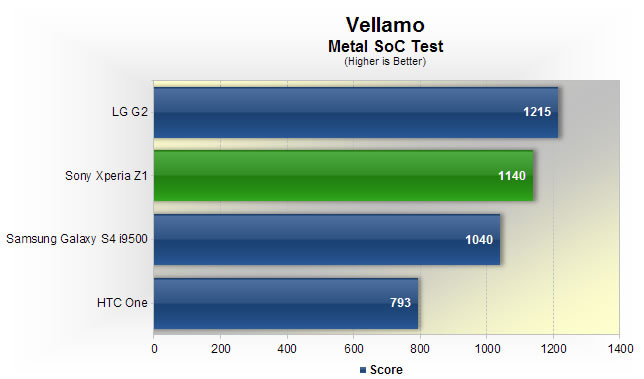Performance
Like many other flagship smartphones released in the second half of 2013, the Xperia Z1 is powered by a Qualcomm Snapdragon 800 SoC; a generational upgrade on the Snapdragon S4 Pro that was used in the Xperia Z. I've spoken in detail about the Snapdragon 800 in my previous reviews of the LG G2 and Sony Xperia Z Ultra. For those who aren't up to date, I'll quickly run through what the Snapdragon 800 brings to the table.
The SoC's die contains four 2.3 GHz Krait 400 CPU cores, an Adreno 330 GPU clocked at 450 MHz, a QDSP6V5A Hexagon DSP at 600 MHz, an LPDDR3 memory controller and a range of radios including LTE and Wi-Fi 802.11ac.
Alongside the Snapdragon 800, Sony has packed in 2 GB of RAM, 16 GB of internal storage with a microSD card slot, NFC, and an array of sensors. There's nothing particularly special in the performance section of the Xperia Z1's spec sheet, but also nothing appears to be missing.
Everything I've said previously in regards to the Snapdragon 800's performance holds up here when using the Xperia Z1. The chipset is extremely fast, and undoubtedly the fastest chipset I've used in an Android device. Everything feels literally at your fingertips when using the Z1: apps open in an instant, multitasking is fluid and speedy, using the UI is smooth and everyday tasks are no match for the crushing power of the Krait 400's cores.
As with the past few Sony devices, the only included browser on the Z1 is Google Chrome, which is similar to (if not faster than) the stock Android browser. Chrome makes good use of all four CPU cores, facilitating smooth pans and zooms around content-heavy websites, which is exactly what you'd expect from a top-tier device. Whether you prefer browsing desktop or mobile versions of websites, the Z1 is more than capable.
The Adreno 330 GPU, which is used for the first time in the Snapdragon 800 SoC, is relatively new to the mobile market, and its power has yet to be fully harnessed by game developers. This means any game you throw at the Z1 will have no trouble being run fluidly, even 'intense' titles such as Grand Theft Auto: Vice City and Real Racing 3. If you're into Android gaming, you'll find the Z1 is more than suitable for your needs.
Interestingly, like a few other Sony devices I've used in the past, the Xperia Z1 appears to have a few issues with wireless networks. It's the only device I've used that simply refuses to upload photos over my home Wi-Fi network, and in areas of HSPA coverage I would often spontaneously lose data connections. As the actual hardware is the same as in other devices which don't exhibit these issues, it leads me to believe something is not quite right on the software front.
Moving on to benchmarks, and as seen in a number of other Android devices recently, this handset cheats in certain benchmarks, including Quadrant, Linpack and Vellamo. By cheating, we mean there is specific code included in the device's OS that sets the CPU clock speed to 2.2 GHz as soon as specific benchmarks are run. The code only affects benchmarks, potentially altering the scores that are output, and providing no 'real world' gains. Luckily the only benchmark we use that the Z1 cheats in is Vellamo, so be wary of the results we post below.



In both Futuremark's Peacekeeper in-browser benchmark and Qualcomm's Vellamo benchmark we see the Z1 performing on-par with other Snapdragon 800 devices, namely the LG G2 and Xperia Z Ultra. You'll notice in Peacekeeper specifically that the iPhone 5s' A7 chip absolutely dominates the Snapdragon 800, posting a 78% performance gain.

In the 3DMark Ice Storm benchmark we see the Xperia Z1 edging out the G2 with a 6% advantage, however at this stage - with Android games not using GPUs to their full potential - this difference won't mean much during actual gaming.


Once again, in GFXBench we see the Adreno 330 perform on-par with other Snapdragon 800-based devices, in both the Egypt and T-Rex tests. Here you'll also notice the iPhone 5s coming out with an on-screen performance advantage due to the lower display resolution.

When testing the internal storage performance, the Z1 managed average speeds of around 30 MB/s for both reading and writing large files, which is acceptable. Anyone who picks up this device will no doubt be happy to see the inclusion of a microSD card slot alongside 16 GB of internal storage; the internal NAND is great for apps and the expansion slot can be used if you have a lot of music or videos you want to chuck on the handset.
Comparing the Xperia Z1 to the Xperia Z, released at the start of this year, shows the Z1 as being roughly 30% faster overall, and twice as fast in the graphics department. This may seem like a significant difference, but it's probably not worth upgrading to a Z1 if you have the older Z as both devices still feel fast, and the difference in actual in-game frame rates is minimal due to a lack of really 3D-heavy games. On the other hand, if you're using last year's Xperia S, it's certainly worth an upgrade as the Z1 is more than twice as fast.
If you're just looking for a high-end Android device that's fast and capable, the Xperia Z1 is definitely one of the best choices.



